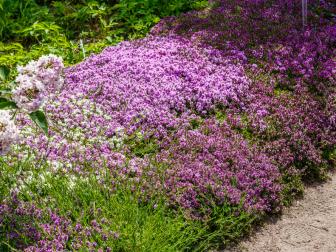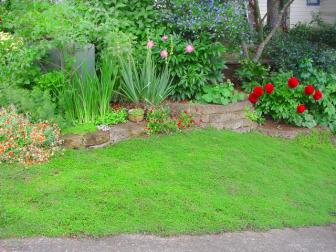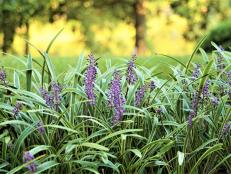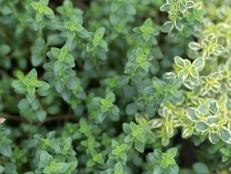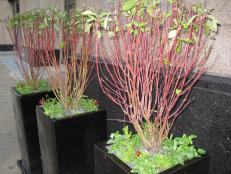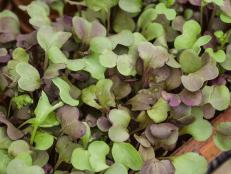How to Grow and Enjoy Red Creeping Thyme
Discover the easygoing versatility of red creeping thyme plants, and learn how to grow and enjoy them abundantly in your garden or landscape.

Ball Horticultural Company

Thyme is ubiquitous in our herb gardens and spice drawers, but the thyme genus offers much to covet beyond its culinary value. The upright-growing species of thyme (like English or lemon thyme) are most common for herb gardening and kitchen use. Although it’s less useful for culinary harvest (but still edible), creeping thyme blankets spaces with prolific color and scent and helps support healthy ecosystems in the toughest parts of the landscape. While there are several types of this ground covering herb, red creeping thyme is especially popular for its bright blooms, which carpet the ground in rich, lavender-to-wine hues.
All About Red Creeping Thyme
Red creeping thyme (Thymus praecox ‘Coccineus’) is a drought-tolerant, sun-loving, herbaceous perennial belonging to the mint (Lamiaceae) family. Although it appears delicate, this thyme adapts well to a range of well-draining environments and even tolerates light foot traffic. These attributes make it a low-maintenance and beginner-friendly plant. Hardy to Zones 4-9, red creeping thyme remains evergreen in milder regions, and the foliage takes on a bronzed hue in autumn. You may find this plant referred to as Thymus serpyllum, or by other common names like crimson thyme and mother of thyme.
Like other thyme species, red creeping thyme attracts butterflies and hosts beneficial insects, making it a wise choice for those who want to steward biodiversity. Red creeping thyme also earns winning marks as a deer deterrent. The summer blooms of red creeping thyme range from purple to crimson and form a dense blanket of color above wide-spreading, low-growing 4-inch-tall foliage with a 12- to 18-inch spread. This density of growth helps suppress weeds and fill tricky gaps in the landscape.
Popular applications for red creeping thyme include walkways, rock gardens, xeriscapes, retaining walls, understories, alternative lawns and container gardens. Dive in and discover how to grow and enjoy red creeping thyme plants in your space. There’s little doubt you’ll keep this versatile plant in your back pocket once you’re acquainted with its striking beauty and versatility.
How to Grow Red Creeping Thyme Plants
Starting Red Creeping Thyme Plants
Red creeping thyme may be grown from seed or from nursery plants. However, thyme is slow-growing, and seeds for this variety are not widely available. For ease and efficiency, purchasing plants is recommended. If you are planting a drift or large cluster of creeping thyme, it’s economical to find plugs — the smaller-sized transplants that landscapers buy in bulk, which offer the best value when planting large quantities (say, 30 or more plants). Plugs have less established root systems than larger transplants, so care must be taken to keep them well-watered as they get settled. When plant shopping, look for plants sporting verdant foliage; avoid waterlogged, rotting roots.
Preparing a Bed for Red Creeping Thyme
Once you’ve sourced healthy red creeping thyme plants, select a sunny location where they can happily spread. Creeping thyme tolerates partial shade, but full sun (6+ hours a day) is ideal for peak flowering. Next, make sure soil drainage is excellent. Amend the soil with compost, leaf mold or soil conditioner to lighten the structure, adding sand if you have heavy, clay-based soils.
Planting Red Creeping Thyme
Plant red creeping thyme either in spring or in fall — it’s tough for young plants to get established in summer’s heat. Spacing depends on what size plants you start with, how large your space is and how quickly you want the landscape to fill with growth.
Great Garden Plants outlines the following spacing when starting with 32 landscape plugs (a common tray size): 6-inch spacing covers 6 square feet; 8-inch spacing covers 7.5 square feet; 10-inch spacing covers 11 square feet; and 12-inch spacing covers 16 square feet. If you’re purchasing larger plants from the garden center, 10- to 12-inch spacing is recommended. For different varieties of creeping thyme, check the plant tag for spacing recommendations. To achieve a quicker groundcover, plant creeping thyme a bit closer.
Lay plants out at the correct spacing before transplanting and visualize the end result. When planting in drifts, avoid straight lines and opt for more organic shapes that follow the landscape’s natural curves. Once the overall design scheme looks balanced — maybe a tidy border, a lush drift or a carpet of fuchsia color — get busy planting and enjoy the process.
To transplant thyme, dig each hole a bit wider and deeper than the root ball; loosen the soil with your fingers and gently untangle the roots. If you’ve properly amended the soil, it should be loose and light. Settle each plant into its hole, gently filling the soil back around the roots. Use your hands to firmly press the soil into place and water thoroughly. Especially when planting plugs, maintain consistent soil moisture to help the young roots establish themselves. Once they settle in, red creeping thyme plants are drought tolerant.
Red Creeping Thyme Propagation
Propagating red creeping thyme is simple, either by stem cutting or division. To take a stem cutting, snip a few stems that are not flowering, strip off the lower leaves and place them in water on a windowsill to grow roots. Once some roots have emerged, cuttings may be potted.
Red creeping thyme may also be divided. As the plants spread, pry up a root ball and divide it in half. Replant one half and transplant or gift the second. Remember to water thoroughly to help the roots recover from the stress. Division is best done in spring or early fall, every few seasons. If you start with closer plant spacing, you may find that division needs to be done sooner.
How to Care for Red Creeping Thyme Plants
Watering and Fertilizing Red Creeping Thyme
Red creeping thyme enjoys moderate water and likes to dry between waterings. For some spaces and seasons, rainfall alone can suffice since creeping thyme is drought tolerant. During hot and dry summers, routinely watering thyme is a good idea. Observe your plant for indications of its needs in your space. Younger plants need more regular water.
Thyme is not a heavy feeder, so it’s not critical to fertilize when planting into healthy soil. However, applying a balanced, organic fertilizer each spring may help generate lush growth, particularly in deficient soil. When fertilizing, reach for something organic and slow-release (like Espoma’s Plant Tone) and follow the application instructions precisely. Topdressing with compost or leaf mold gently boosts the soil’s nutritional content, structure and microbial activity, and may be used instead of fertilizer for low-maintenance plants like creeping thyme.
Weeding and Mulching Red Creeping Thyme
One of the greatest benefits of planting red creeping thyme is its quick-spreading, weed-suppressing power. Weeding in the first season is essential when thyme isn’t yet established. Suppress weeds organically through a 2- to 3-inch layer of mulch, like leaf mold. Not only will mulch prevent weeds, it will help retain moisture and protect roots from temperature swings, helping young plants get a foothold. Mulch is also helpful for protecting plants through winter, especially in cold, northern climates.
Red Creeping Thyme Pests and Disease
All thyme species contain natural antibacterial and antifungal properties that repel pests and disease, making it a stellar neighbor to other plants. The primary problem to look out for is root rot; if soil drainage is poor, red creeping thyme is likely to suffer. If you lose plants to root rot, amend the soil with sand and other organic matter like compost or leaf mold, and then replant, paying close attention to moisture levels.
Pruning Red Creeping Thyme
Pruning twice annually helps red creeping thyme plants continue producing tender, verdant stems that flower abundantly. The first pruning should be done in early spring; the action of cutting stems back generates leafy growth, supported by spring’s gentle warmth and nourishing rains. The second pruning should be done after flowering. Simply snip back spent stems to encourage a second flush of flowers. Avoid pruning close to frosts to prevent damage to new growth.
If you’ve planted red creeping thyme in a smaller area, pruning may be done with hand tools like garden shears or pruners. If you’re working with a large drift, walkway or lawn of thyme, a lawn mower may be used at its highest (ideally 4-inch) setting. There should still be a few sets of leaves per stem after pruning — avoid cutting too close to soil level.
Designing With Red Creeping Thyme
Establishing a colorful, eco-friendly ground cover with red creeping thyme can transform a landscape. The impact of blending and marrying taller plants with visually cohesive, low-growing plants is powerful — like the layering of color and texture in a painting. With a little creativity and knowledge of this versatile plant’s affinities, red creeping thyme might just become a staple of your garden projects. Explore top uses of red creeping thyme and envision how this plant might transform your space.
Rock Gardens
Designing a rock garden is a stellar solution to tricky areas like steep slopes and hot, dry conditions. By placing boulders and surrounding them with low-maintenance, drought-tolerant perennials like red creeping thyme, you can bring structure to the landscape while keeping water and maintenance needs low. Fill gaps between rocks with drifts of plants at varied heights. Plant red creeping thyme toward the front of the design and stagger increasingly taller plantings to create a lovely, tiered effect. Other plants to consider include sedum, rudbeckia, Shasta daisy, ornamental grasses, lavender and mungo pine.
Learn About Creeping Thyme
Learn about the other types of creeping thyme and which varieties to try in your garden.
Xeriscapes
Similar to rock gardens, xeriscapes are low water-use designs that may or may not involve rocks and other hardscaping. Suitable to most any style of gardening, adopting a xeriscape strategy means sticking to plants that do not require much (if any) water, beyond rainfall. Plants are grouped together in “irrigation zones” according to their requirements. Red creeping thyme is a top groundcover contender for xeriscaping. Combine it with other drought-tolerant perennials, ideally those native to your region (as these are best adapted to local conditions).
Colorful, Edible Understories
As long as it still receives about six hours of sunlight per day, red creeping thyme makes an excellent groundcover under specimen trees and shrubs. Woodlands are too shady for creeping thyme to flower well, but under smaller groupings or single trees, enough sun can still be had. Permaculture design emphasizes understory plants, which help prevent erosion, host beneficial insects and retain moisture around taller plants. Because of its edible value, red creeping thyme is especially valuable.
18 Tough Groundcovers 18 Photos
Tired of mowing that lawn? Why not replace expensive, high-maintenance sod with an easy-care, environmentally-friendly groundcover?
Living Pathways
Because it tolerates light foot traffic and forms a dense mat of foliage and flowers, red creeping thyme makes a fantastic ground cover for pathways. Plants can be tucked around and between stepping stones or pavers, visually softening the hardscape and bringing sensory delight.
Container Gardens
The popular “thriller, filler, spiller” formula of container design encourages a combination of tall plants (thrillers), bushier plants (fillers) and trailing plants (spillers). Red creeping thyme makes an excellent spiller component for full-sun containers. Try pairing it with other purple-red plants for an analogous color scheme, or with yellow flowers for a striking, complementary palette. For an edible and beautiful design, try pairing red creeping thyme with eggplant (thriller) and purple basil (filler), or lemongrass (thriller) and tangerine gem marigolds (filler).
Companion Planting
Anywhere you need a groundcover in the vegetable or ornamental garden, consider red creeping thyme for its astounding companion plant attributes: It repels deer, attracts beneficial insects, deters cabbage worms and has natural antimicrobial properties. While the upright thyme varieties are more notable for their culinary value and abundant harvests, creeping thyme shares some of that fragrance and flavor, so it makes sense as a kitchen-garden companion. Using it as a border plant lends a more formal, polished look to the vegetable garden. With such wide-ranging uses and benefits, red creeping thyme is easy to grow and easier to love.
Red Creeping Thyme Lawn as a Grass Alternative
Traditional grass lawns have their merits and nostalgic value, but there is rising awareness of their unsustainable use of water, herbicides and pesticides, as well as their lack of ecosystem value. As we face devastating losses of natural habitats and, consequently, of beneficial insect species, many landscapers and homeowners are looking for lawn alternatives that bolster, rather than deplete, biodiversity. Enter low-maintenance, flowering groundcovers like creeping thyme. Imagine a lawn that blooms, and releases a clean, lemony scent when you step on it.
As long as foot traffic in the area is relatively light, and the space receives ample sunlight, red creeping thyme can be used to create small, low-maintenance, eco-friendly alternative lawns. Some companies, like American Meadows, sell seed mixes specifically for this purpose.






